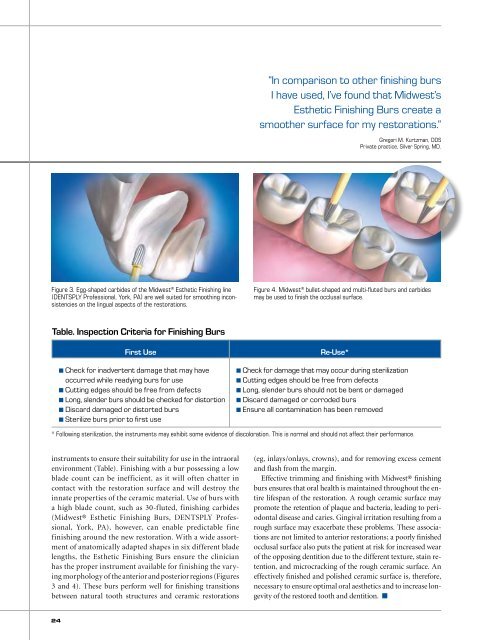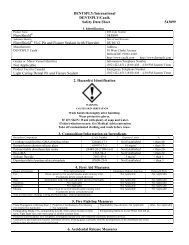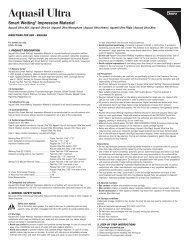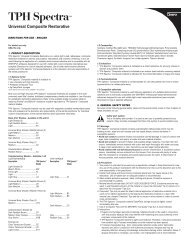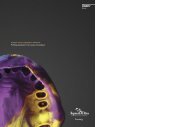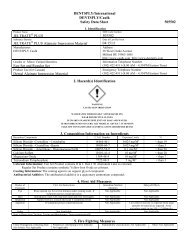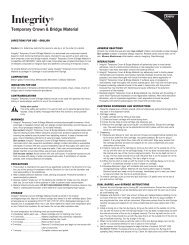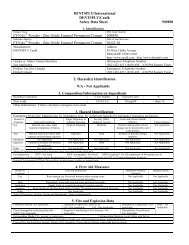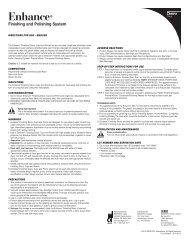Indirect and Direct Restorative Protocols - Caulk
Indirect and Direct Restorative Protocols - Caulk
Indirect and Direct Restorative Protocols - Caulk
Create successful ePaper yourself
Turn your PDF publications into a flip-book with our unique Google optimized e-Paper software.
“In comparison to other finishing burs<br />
I have used, I’ve found that Midwest’s<br />
Esthetic Finishing Burs create a<br />
smoother surface for my restorations.”<br />
Gregori M. Kurtzman, DDS<br />
Private practice, Silver Spring, MD.<br />
Figure 3. Egg-shaped carbides of the Midwest ® Esthetic Finishing line<br />
(DENTSPLY Professional, York, PA) are well suited for smoothing inconsistencies<br />
on the lingual aspects of the restorations.<br />
Figure 4. Midwest ® bullet-shaped <strong>and</strong> multi-fluted burs <strong>and</strong> carbides<br />
may be used to finish the occlusal surface.<br />
Table. Inspection Criteria for Finishing Burs<br />
First Use<br />
n Check for inadvertent damage that may have<br />
occurred while readying burs for use<br />
n Cutting edges should be free from defects<br />
n Long, slender burs should be checked for distortion<br />
n Discard damaged or distorted burs<br />
n Sterilize burs prior to first use<br />
Re-Use*<br />
n Check for damage that may occur during sterilization<br />
n Cutting edges should be free from defects<br />
n Long, slender burs should not be bent or damaged<br />
n Discard damaged or corroded burs<br />
n Ensure all contamination has been removed<br />
* Following sterilization, the instruments may exhibit some evidence of discoloration. This is normal <strong>and</strong> should not affect their performance.<br />
instruments to ensure their suitability for use in the intraoral<br />
environment (Table). Finishing with a bur possessing a low<br />
blade count can be inefficient, as it will often chatter in<br />
contact with the restoration surface <strong>and</strong> will destroy the<br />
innate properties of the ceramic material. Use of burs with<br />
a high blade count, such as 30-fluted, finishing carbides<br />
(Midwest® Esthetic Finishing Burs, DENTSPLY Professional,<br />
York, PA), however, can enable predictable fine<br />
finishing around the new restoration. With a wide assortment<br />
of anatomically adapted shapes in six different blade<br />
lengths, the Esthetic Finishing Burs ensure the clinician<br />
has the proper instrument available for finishing the varying<br />
morphology of the anterior <strong>and</strong> posterior regions (Figures<br />
3 <strong>and</strong> 4). These burs perform well for finishing transitions<br />
between natural tooth structures <strong>and</strong> ceramic restorations<br />
(eg, inlays/onlays, crowns), <strong>and</strong> for removing excess cement<br />
<strong>and</strong> flash from the margin.<br />
Effective trimming <strong>and</strong> finishing with Midwest® finishing<br />
burs ensures that oral health is maintained throughout the entire<br />
lifespan of the restoration. A rough ceramic surface may<br />
promote the retention of plaque <strong>and</strong> bacteria, leading to periodontal<br />
disease <strong>and</strong> caries. Gingival irritation resulting from a<br />
rough surface may exacerbate these problems. These associations<br />
are not limited to anterior restorations; a poorly finished<br />
occlusal surface also puts the patient at risk for increased wear<br />
of the opposing dentition due to the different texture, stain retention,<br />
<strong>and</strong> microcracking of the rough ceramic surface. An<br />
effectively finished <strong>and</strong> polished ceramic surface is, therefore,<br />
necessary to ensure optimal oral aesthetics <strong>and</strong> to increase longevity<br />
of the restored tooth <strong>and</strong> dentition. n<br />
24


